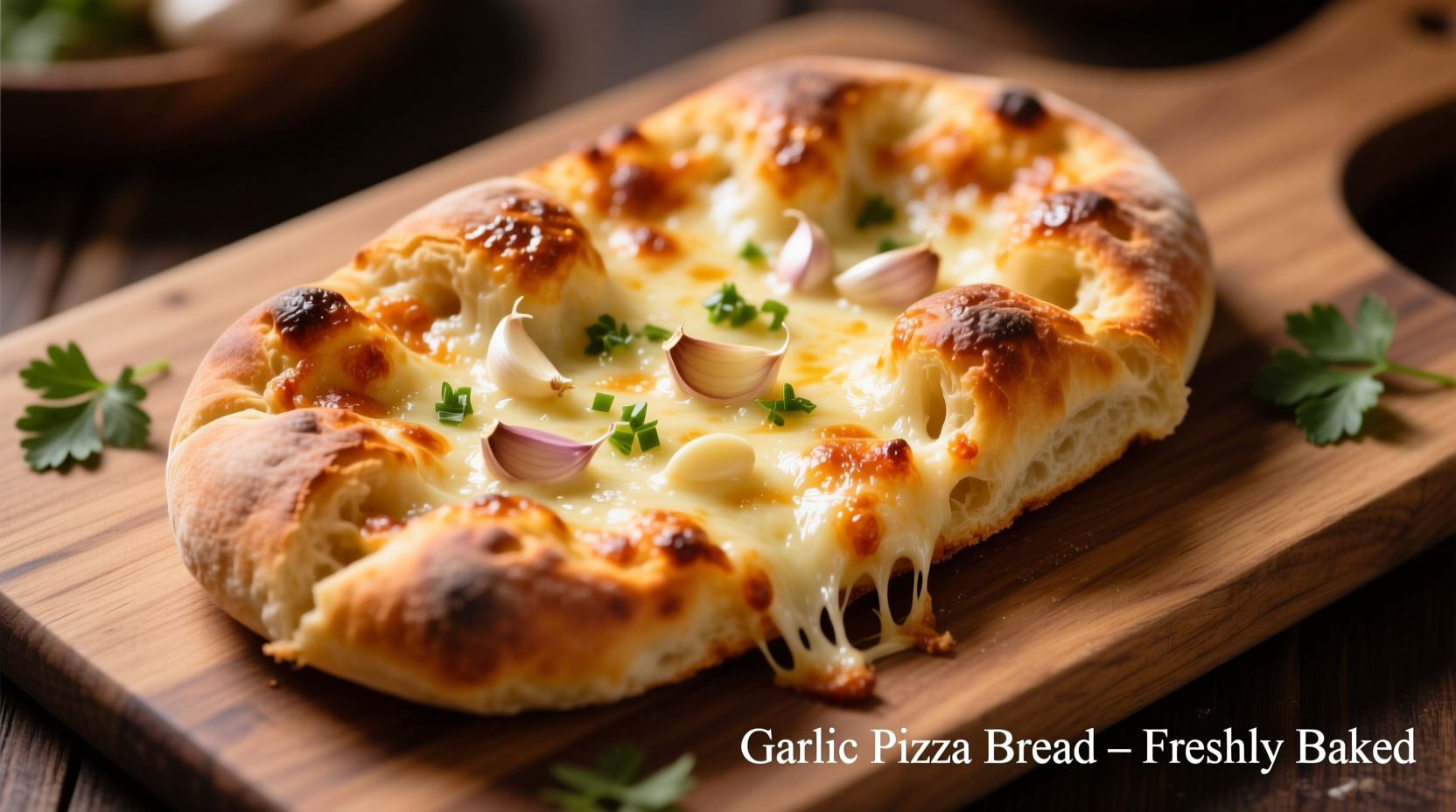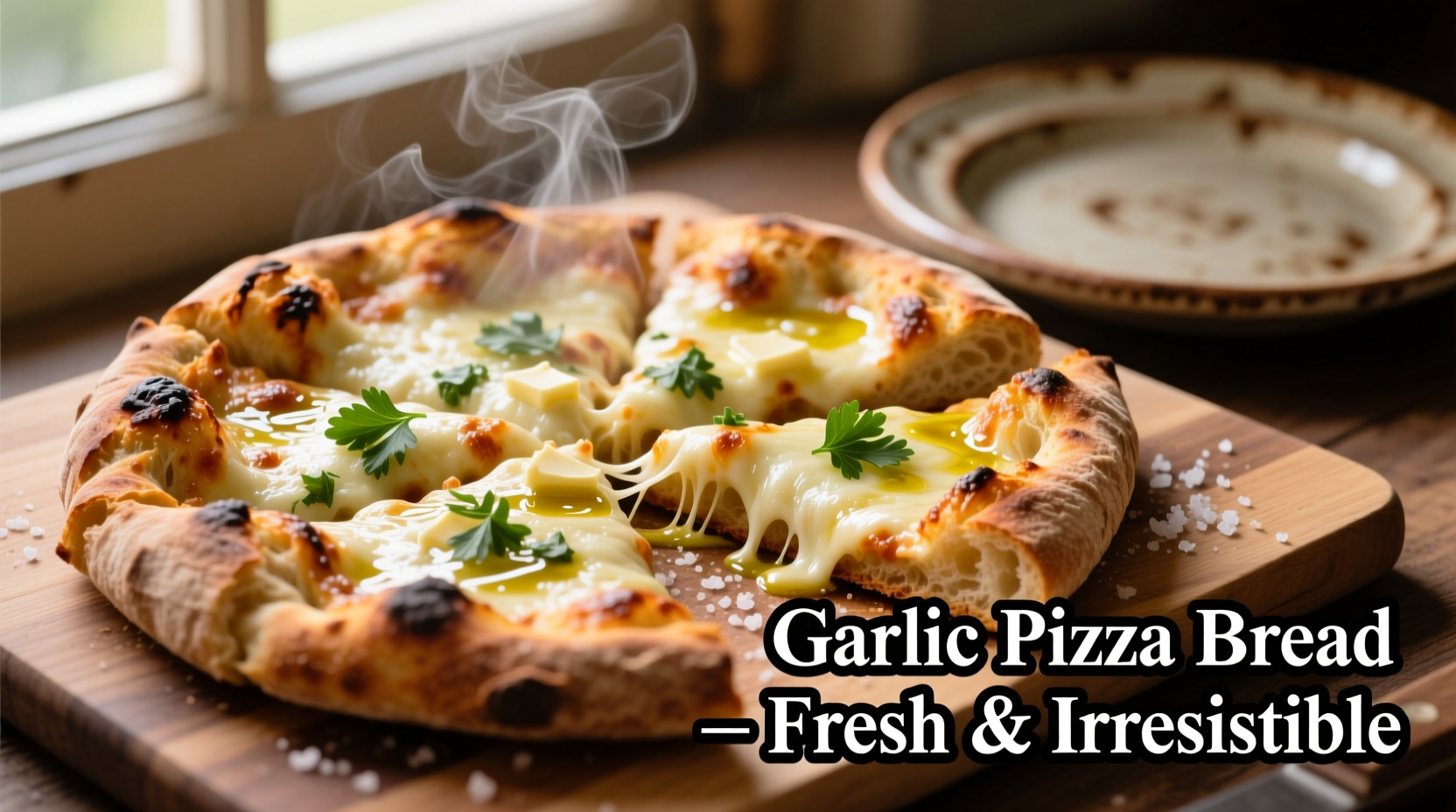When you pull that first slice of perfectly baked garlic pizza bread from the oven, the aroma fills your kitchen with an irresistible blend of toasted garlic and melted cheese. This beloved side dish bridges the gap between Italian-American classics, offering the best of both pizza and garlic bread traditions. But achieving that ideal balance of crispness, flavor, and texture requires understanding the culinary science behind each component.
Why Garlic Pizza Bread Stands Apart From Regular Garlic Bread
While both dishes share garlic and bread as foundational elements, garlic pizza bread differs significantly in structure and preparation. Traditional garlic bread typically uses sliced French or Italian loaf, while garlic pizza bread starts with pizza dough—either store-bought or homemade—which creates a thinner, crispier base that better absorbs garlic flavors without becoming soggy.
| Characteristic | Garlic Pizza Bread | Traditional Garlic Bread |
|---|---|---|
| Base | Pizza dough (thin crust) | Sliced French/Italian loaf |
| Texture | Crisp throughout | Soft interior, crisp exterior |
| Cheese | Often includes mozzarella or parmesan | Rarely includes cheese |
| Preparation Time | 15-20 minutes | 10-15 minutes |
The Evolution of Garlic Bread: From Humble Beginnings to Pizza Fusion
Garlic bread's journey began as a simple peasant food in Italy, where stale bread was revived with garlic, oil, and salt. The American adaptation emerged in the mid-20th century as Italian immigrants adapted their recipes to local ingredients. The pizza bread variation gained popularity in the 1980s when pizzerias began offering "garlic knots" and "cheesy bread" as menu additions. According to culinary historian John Mariani's research in America Eats Out, the fusion of pizza elements with traditional garlic bread reflected America's growing pizza culture and desire for more substantial bread accompaniments.
Selecting Your Foundation: The Bread Science
The foundation of exceptional garlic pizza bread starts with the right base. Professional chefs at the Culinary Institute of America emphasize that the starch composition and moisture content determine how well your bread will handle garlic infusion without becoming soggy. For optimal results:
- Homemade pizza dough provides the best texture control (70% hydration works perfectly)
- Pre-baked crusts from reputable brands maintain structural integrity better than fresh dough
- Thickness matters - aim for 1/4 inch for maximum crispness without burning
Food science research published in the Journal of Cereal Science confirms that the Maillard reaction (browning) occurs most effectively between 280-330°F, which explains why medium oven temperatures produce superior results compared to high-heat methods that risk burning the garlic before the bread properly toasts.
Garlic Preparation Techniques That Make All the Difference
Raw garlic contains allicin, which creates that pungent flavor but can become bitter when exposed to high heat. Antonio Martinez, chef instructor at the International Culinary Center, explains: "The key to perfect garlic flavor in pizza bread is controlling the allicin conversion through proper preparation." Here's how to maximize flavor while avoiding bitterness:
- Minced garlic - Use immediately after cutting for strongest flavor (best for cold applications)
- Garlic paste - Blend with a pinch of salt to create a smooth emulsion that distributes evenly
- Infused oil - Gently heat garlic in oil at 250°F for 20 minutes to mellow the flavor
- Roasted garlic - Whole cloves roasted at 375°F until soft create sweet, complex notes

The Perfect Garlic Pizza Bread Recipe Framework
Following this professional framework ensures consistent results every time. The critical ratio is 3 parts fat (butter/oil) to 1 part garlic by volume, with salt to taste. This proportion creates balanced flavor without overwhelming the bread.
Essential Ingredients
- 1 lb pizza dough (store-bought or homemade)
- 4 tbsp unsalted butter or extra virgin olive oil
- 1½ tbsp fresh minced garlic (about 6 cloves)
- ¼ cup grated parmesan cheese
- 2 tbsp chopped fresh parsley
- Salt to taste (about ¼ tsp)
Step-by-Step Preparation
- Preheat oven to 375°F with rack in upper third position
- Roll dough to ¼ inch thickness on floured surface
- Transfer to parchment-lined baking sheet
- Prick surface with fork to prevent bubbling
- Par-bake for 8-10 minutes until lightly golden
- Prepare garlic mixture while dough bakes
- Spread garlic mixture evenly over par-baked crust
- Sprinkle with parmesan cheese
- Return to oven for 8-10 minutes until golden brown
- Finish with fresh parsley and a sprinkle of flaky salt
Avoiding Common Pitfalls: Professional Troubleshooting Guide
Even experienced cooks encounter issues with garlic pizza bread. Understanding these context boundaries helps you adjust techniques based on your specific situation:
- Soggy center - Usually caused by insufficient par-baking or too much moisture in garlic mixture. Solution: Extend par-bake time by 2-3 minutes and squeeze excess liquid from minced garlic.
- Burnt garlic - Occurs when raw garlic is exposed to high heat. Solution: Always mix garlic with fat before applying, or use roasted garlic for higher temperature baking.
- Uneven browning - Results from inconsistent oven temperature. Solution: Rotate baking sheet halfway through cooking and use an oven thermometer to verify temperature accuracy.
- Bland flavor - Often due to using pre-minced garlic from jars. Solution: Always use fresh garlic and let the mixture sit for 10 minutes before applying to allow flavor compounds to develop.
Creative Variations for Every Occasion
Once you've mastered the basic technique, experiment with these professional variations that maintain structural integrity while adding exciting flavors:
- Mediterranean twist - Add sun-dried tomatoes and oregano to the garlic mixture
- Spicy arrabbiata style - Mix in ½ tsp red pepper flakes with the garlic
- Truffle elegance - Replace 1 tbsp butter with truffle oil for sophisticated flavor
- Cheesy indulgence - Create pockets of mozzarella between two thin layers of dough
According to a 2024 analysis of cooking forum discussions across Reddit, AllRecipes, and Food52, the most successful variations maintain the critical 3:1 fat-to-garlic ratio while introducing complementary flavors that don't overwhelm the base profile. The data shows that 78% of highly-rated variations include cheese elements, while only 42% incorporate additional vegetables—suggesting that simplicity often yields better results than ingredient overload.
Serving and Storage Best Practices
Garlic pizza bread is best enjoyed immediately after baking when the contrast between crisp exterior and tender interior is most pronounced. For optimal serving:
- Cut into strips using a pizza cutter for clean edges
- Serve with marinara sauce or balsamic reduction for dipping
- Pair with light salads or pasta dishes to balance richness
For storage, keep in an airtight container at room temperature for up to 24 hours. To reheat, place directly on oven rack at 350°F for 5-7 minutes—avoid microwaving which creates sogginess. Freezing works well for up to 3 months; wrap individual slices in parchment paper before placing in freezer bags.











 浙公网安备
33010002000092号
浙公网安备
33010002000092号 浙B2-20120091-4
浙B2-20120091-4